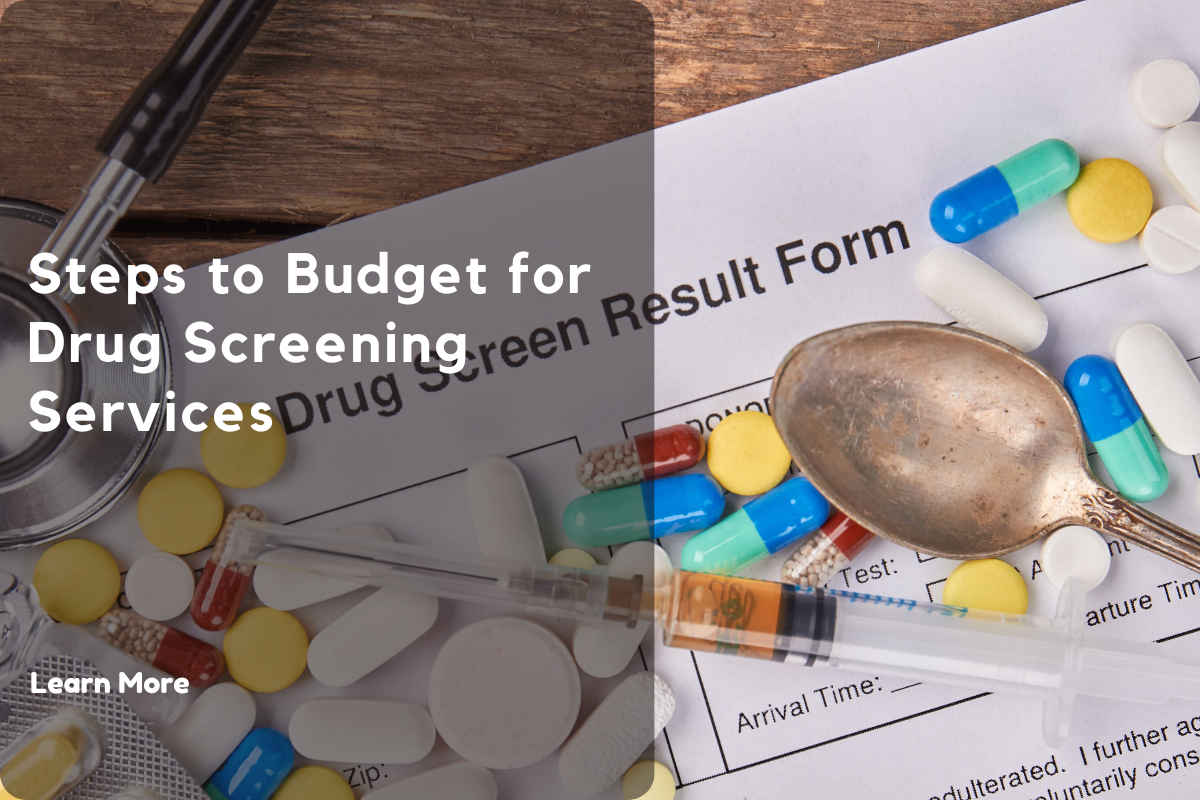 What Is Drug Screening and Why Is It Important?
What Is Drug Screening and Why Is It Important?
Drug screening is a process used to test individuals for the presence of illicit substances or certain prescription medications. In many industries, particularly those related to safety, healthcare, and high-risk operations, drug screening is vital to maintaining a safe and productive workplace. Employers use drug tests to ensure that employees are not under the influence of drugs while performing tasks, which could otherwise compromise safety or performance. Healthcare providers use drug tests to monitor patients, track prescription compliance, or diagnose substance abuse issues. Individuals may also undergo drug screening as part of personal or legal requirements, such as during probation or for certain certifications.
In the context of business, drug screening is most commonly performed as part of the pre-employment process, random drug tests during employment, or as part of compliance with federal or state regulations. The cost of drug screening is a significant consideration for businesses, particularly those with large numbers of employees or ongoing screening programs. As such, understanding drug screening costs is essential for both employers and individuals.
Types of Drug Tests and Their Cost
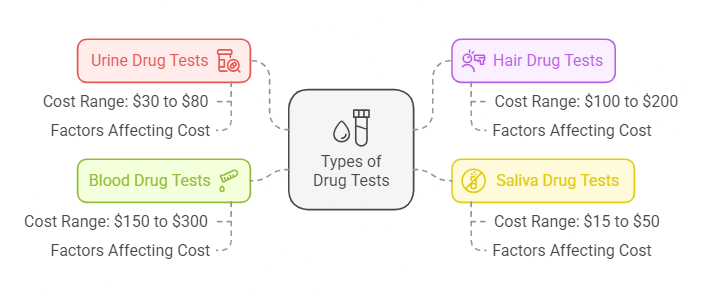
There are several types of drug tests commonly used in screening, each with its unique pricing structure. The most common types include:
1. Urine Drug Tests
Urine tests are the most widely used and cost-effective form of drug screening. They are typically used in both pre-employment and random drug tests. The urine drug test can detect a wide range of substances, including marijuana, cocaine, opiates, amphetamines, and more.
- Cost Range: $30 to $80 per test.
- Factors Affecting Cost: The cost may vary depending on the number of substances being tested for (basic or expanded panel), the location of the test, and whether any additional services, such as a medical review, are included.
2. Hair Drug Tests
Hair follicle testing has become increasingly popular as it can detect drug use over a longer period, typically up to 90 days. Unlike urine tests, which can only show recent drug use, hair tests provide a more comprehensive view of a person’s drug history.
- Cost Range: $100 to $200 per test.
- Factors Affecting Cost: Hair tests are more expensive than urine tests due to the longer detection window and additional testing protocols. Costs may also increase based on the length of the hair sample and the substances tested.
3. Saliva Drug Tests
Saliva tests are less invasive than urine or hair tests and are often used in random or on-the-spot testing, particularly in workplace environments. Saliva tests typically detect recent drug use, often within the past 24 to 48 hours.
- Cost Range: $15 to $50 per test.
- Factors Affecting Cost: The cost depends on the testing kit used and the substances being tested for. Saliva tests are the least expensive of the four main types of tests, but they are also limited in the types of drugs they can detect and the detection window.
4. Blood Drug Tests
Blood tests are typically used for more serious investigations, such as legal matters or medical diagnoses. Blood tests are the most accurate and reliable form of drug testing, as they can provide immediate results and detect substances in the bloodstream.
- Cost Range: $150 to $300 per test.
- Factors Affecting Cost: Blood tests are more expensive due to the complexity of the process, the need for a medical professional to draw the sample, and the more advanced analysis required to test the blood for drugs.
Factors Affecting Drug Screening Costs
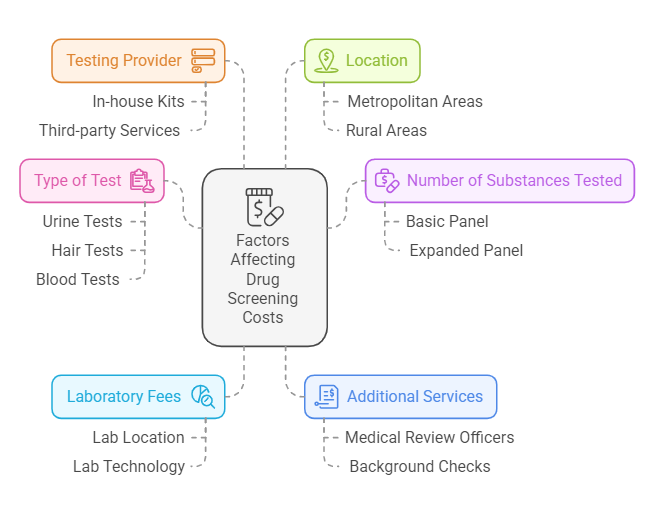
Several factors influence the cost of drug screening, including:
1. Type of Test
As mentioned, the type of test is one of the most significant cost determinants. Urine tests tend to be the cheapest, while hair and blood tests tend to be the most expensive due to their accuracy and longer detection windows.
2. Number of Substances Tested
Some drug tests, particularly urine tests, may be tailored to test for a specific panel of drugs, while others may test for a wider range of substances. Expanded panels will increase the cost of the test. A basic panel may test for five substances, whereas an expanded panel might test for up to 12 or more drugs.
3. Laboratory Fees
Drug tests are often analyzed in labs, and the associated laboratory fees can vary depending on the lab’s location, technology, and testing protocols. Laboratories with more advanced equipment or faster turnaround times may charge higher fees for drug testing.
4. Additional Services
Some testing companies provide additional services, such as medical review officers (MROs) who interpret test results, or background checks that include criminal records or employment history. These additional services will naturally add to the cost of the screening.
5. Testing Provider
The cost of drug screening can also vary depending on the provider. Some employers opt for in-house drug testing kits, which can be less expensive but may not offer the same level of accuracy or reliability as tests conducted by professional third-party services. Additionally, testing providers may offer bulk discounts or membership programs for companies that require frequent or large-scale testing.
6. Location
Drug screening costs may also vary by location, with prices typically being higher in larger metropolitan areas due to higher operational costs for labs and medical providers.
Average Cost of Drug Screening in Different Situations
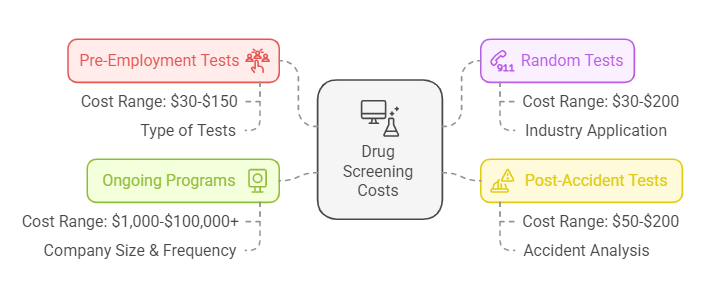
The cost of drug screening can vary based on the context in which it is required:
1. Pre-Employment Drug Tests
Pre-employment drug testing is common across many industries. For employers, this is often the first step in ensuring that potential hires meet safety and health standards. Employers can expect to pay between $30 to $150 per test, depending on the type of test selected.
2. Random Drug Tests
Random drug testing is a routine practice for employees in certain industries, particularly those involving safety-sensitive positions. Random drug tests typically cost between $30 to $80 for urine tests and can go up to $200 for more comprehensive tests like hair follicle testing.
3. Post-Accident Drug Testing
In cases where an employee is involved in a workplace accident, employers may require drug testing to determine whether substance use was a contributing factor. These tests can cost between $50 to $200, depending on the type of test conducted.
4. Ongoing Drug Testing Programs
Some employers implement ongoing drug testing programs for all or some employees, particularly in industries that have a higher risk of accidents. The cost of these programs can range from a few thousand dollars to several hundred thousand dollars annually, depending on the size of the company and the frequency of testing.
How Employers Can Budget for Drug Screening Costs
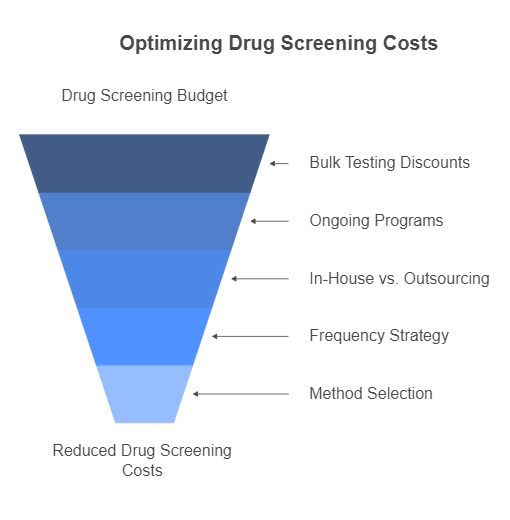
For employers, particularly those managing large teams or working in industries with strict regulatory requirements, budgeting for drug screening costs is essential. Drug testing is a necessary expense, but it can quickly add up, especially when dealing with high volumes of employees or frequent testing.
Here are some key considerations to help employers manage their drug screening budget effectively:
1. Bulk Testing and Group Discounts
One of the most effective ways to manage drug screening costs is by opting for bulk testing or group discounts. Many testing providers, including companies like Rapid Hire Solutions, offer discounts for businesses that need to screen a large number of employees regularly. By purchasing drug tests in bulk or committing to long-term contracts, employers can significantly reduce the per-test cost.
Additionally, some providers may offer discounts if the company agrees to conduct a set number of tests per year. For companies with ongoing drug testing needs, such as transportation companies, construction firms, or manufacturers, bulk pricing can save hundreds to thousands of dollars annually.
2. Ongoing Screening Programs
Employers who need to implement ongoing screening programs should consider the long-term cost of such programs. Regular or random drug tests can be scheduled on a quarterly, semi-annual, or annual basis, depending on the company’s needs. Businesses can often save on testing costs by negotiating with providers to lock in lower prices for long-term contracts.
To ensure they remain compliant with regulatory requirements while minimizing costs, employers should integrate drug testing into their health and safety programs. For example, employers in the transportation industry are required by federal regulations to conduct regular drug and alcohol testing. By scheduling tests well in advance, employers can avoid last-minute rush fees and ensure the process runs smoothly.
3. In-House Drug Testing Kits vs. Third-Party Providers
Employers may be tempted to use in-house drug testing kits to save money. While these kits can be cheaper upfront, they often lack the accuracy and reliability that certified third-party laboratories provide. False positives, misinterpretations, or improper collection can lead to legal complications and, ultimately, higher costs for businesses.
On the other hand, outsourcing drug testing to professional providers like Rapid Hire Solutions may cost more per test but ensures the process is handled efficiently and accurately. These providers offer comprehensive services that include lab testing, medical reviews, and proper documentation, all of which are essential for ensuring compliance with laws like the Drug-Free Workplace Act and state-specific regulations.
4. Testing Frequency
The frequency of drug testing plays a large role in determining the overall cost for employers. Regular, random, and post-accident testing all contribute to the cost of drug screening. However, employers may save money by focusing on specific testing methods or periods of higher risk.
For example, employers in high-risk industries, such as transportation, may need to conduct random and post-accident drug tests in addition to pre-employment testing. By strategically scheduling tests or opting for periodic testing based on employee risk profiles, employers can reduce unnecessary testing expenses.
5. Testing Method Selection
The method of drug testing directly impacts the cost. Urine tests are generally the least expensive, while blood tests and hair follicle tests are significantly more costly. To stay within budget, employers should carefully evaluate the specific testing method required for their needs. For example, if employees are required to undergo routine testing, a urine test may be sufficient, whereas a more detailed drug history may require a hair follicle test.
By choosing the appropriate test for the situation, employers can avoid overspending. For instance, while hair tests are more accurate over a longer period, they may not be necessary for every employee or every situation.
Additional Costs of Drug Screening
While the cost of the drug tests themselves is the most significant expense, employers may face additional costs when conducting drug screenings. Understanding these extra fees can help employers plan their budgets more effectively.
1. Laboratory Fees
Drug tests are often sent to laboratories for analysis. These labs charge processing fees, which can vary depending on the type of test, the number of substances being screened, and the lab’s location. For example, blood tests and hair follicle tests typically have higher lab processing fees than urine or saliva tests.
Employers should inquire about any additional lab fees upfront to avoid surprise charges. Some third-party providers offer bundled services that include both the test and lab analysis, which can simplify the budgeting process.
2. Collection Fees
In addition to testing and lab fees, employers may also need to pay for collection fees, particularly for tests that require a medical professional to collect samples (such as blood tests). These fees can vary depending on the collection site or facility. For businesses located in rural areas or regions with fewer testing facilities, collection fees may be higher.
Some employers may also face additional charges for managing the logistics of collecting samples from employees located in multiple locations. To streamline costs, companies can partner with testing providers that offer on-site collection services or mobile testing units.
3. Follow-up Tests
If an employee tests positive for drugs, follow-up tests may be required to confirm the results. These tests can include confirmation testing, such as a gas chromatography-mass spectrometry (GC-MS) test, which adds to the overall cost. Employers should be prepared to handle these additional expenses if they have a policy in place for follow-up testing.
Insurance and Employee Benefits for Drug Testing
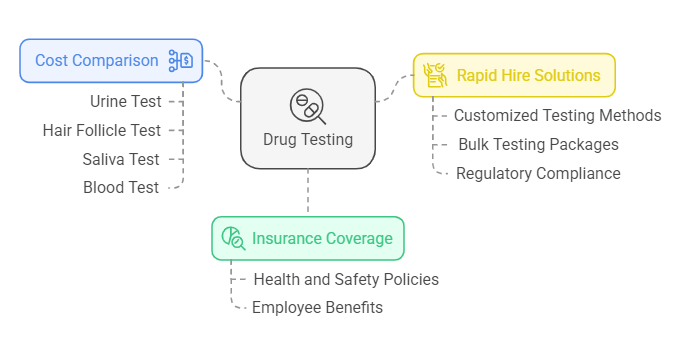
Employers can also explore the possibility of insurance coverage for drug testing. Although it’s rare for insurance policies to cover drug screening directly, some health and safety insurance policies may help offset some of the costs associated with drug testing programs. Additionally, offering drug testing as part of a broader employee benefits package can help attract and retain workers in safety-sensitive positions.
For individuals undergoing drug tests, it’s essential to understand how insurance plans may or may not cover drug testing for personal purposes, such as pre-employment drug tests. Most health insurance policies do not cover drug screening for employment purposes, but some may cover testing in the case of medical necessity or rehabilitation programs.
Cost Comparison Table
Here is a cost comparison table that outlines the typical pricing for different types of drug screening tests:
| Test Type | Cost Range | Factors Affecting Cost |
|---|---|---|
| Urine Test | $30 – $80 | Type of panel (basic vs. expanded), collection and lab fees |
| Hair Follicle Test | $100 – $200 | Length of hair sample, substances tested, lab processing fees |
| Saliva Test | $15 – $50 | Testing kit quality, substances tested, on-site vs. lab analysis |
| Blood Test | $150 – $300 | Collection, lab fees, substances tested |
How Rapid Hire Solutions Helps Manage Drug Screening Costs
Rapid Hire Solutions provides drug screening services that can help businesses streamline their drug testing processes while keeping costs manageable. By offering a variety of drug testing methods, customized to fit the needs of employers, Rapid Hire Solutions ensures that businesses comply with state and federal regulations without incurring unnecessary expenses. Additionally, the company offers bulk testing packages and discounts for long-term contracts, making it easier for businesses to budget and plan for drug screening costs.
Legal Aspects of Drug Screening Costs
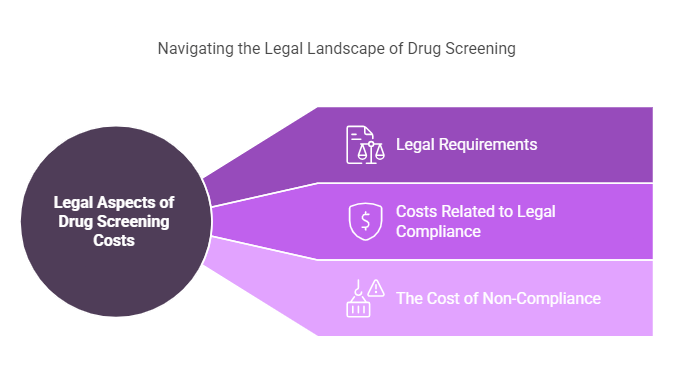
Understanding the legal framework surrounding drug testing is crucial for businesses and individuals. Compliance with both federal and state regulations ensures that drug screening practices are conducted fairly and without discrimination. Below are the key legal considerations for employers and individuals when it comes to drug testing costs and processes.
1. Legal Requirements for Drug Testing in the Workplace
In the United States, drug testing is governed by a range of federal and state laws. While employers are generally allowed to conduct drug testing, there are rules and regulations in place to protect both employees and employers from unfair practices. Some of the primary regulations include:
- Drug-Free Workplace Act (DFWA): The DFWA requires employers in certain industries (such as federal contractors) to maintain a drug-free workplace. Employers who receive federal funding must implement drug testing policies, including pre-employment drug tests and random testing for safety-sensitive jobs.
- Americans with Disabilities Act (ADA): The ADA prohibits discrimination against individuals with disabilities. Employers must ensure that their drug testing policies do not violate these protections, especially when dealing with prescription medication or medical marijuana use. It’s important for employers to provide accommodations for individuals with disabilities when necessary, without compromising the integrity of the workplace.
- State Laws: In addition to federal regulations, individual states have their own laws governing drug testing in the workplace. For example, some states have specific restrictions on drug testing or require employers to notify employees of testing policies. Employers must stay informed about state laws to avoid violating local regulations.
2. Costs Related to Legal Compliance
Employers must consider the costs of maintaining compliance with drug testing laws. For example, failure to adhere to regulations could result in fines, lawsuits, or other penalties. To minimize these risks, businesses should:
- Stay Updated on Local Laws: Drug testing laws can vary significantly from state to state. Employers must be diligent in staying informed about the legal requirements in their specific state to avoid potential penalties.
- Consult Legal Professionals: Consulting with an attorney or legal expert can help employers navigate the complexities of drug testing laws. Legal professionals can help ensure that policies and procedures are in line with federal and state regulations, preventing costly legal challenges in the future.
3. The Cost of Non-Compliance
Failure to comply with drug testing laws can lead to significant costs for businesses, including legal fees, fines, and reputational damage. If an employee is discriminated against during the drug screening process, the company may face lawsuits or penalties from regulatory agencies.
Employers should take the time to create clear, written policies about drug testing, including details about when and how tests will be conducted, who is responsible for them, and how the results will be handled. These policies should be communicated clearly to employees to avoid misunderstandings or legal complications.
Frequently Asked Questions (FAQs) About Drug Screening Costs
Here are some of the most frequently asked questions regarding drug screening costs:
What is the average cost of a drug screening test?
The average cost of a drug screening test can vary significantly depending on the type of test and the testing provider. For instance:
- Urine tests typically range from $30 to $80.
- Hair follicle tests can cost anywhere from $100 to $200.
- Saliva tests may range from $15 to $50.
- Blood tests are typically more expensive, ranging from $150 to $300.
The cost may also be influenced by additional services such as lab processing fees, collection fees, or medical review costs.
How much does a urine drug test cost compared to a hair drug test?
Urine tests are generally much less expensive than hair follicle tests. A urine test typically costs between $30 and $80, while a hair follicle test can cost $100 to $200. The significant difference in price is due to the more advanced technology and longer detection window offered by hair follicle testing.
Do employers pay for drug screening in most cases?
Yes, in most cases, employers cover the cost of drug screening. In fact, many companies make drug testing a part of their pre-employment process, ensuring that potential employees meet the company's standards for drug-free workplaces. However, some employers may charge employees for certain types of testing, particularly in situations involving post-accident or random drug tests.
Can I get a drug test covered by my insurance?
Generally, insurance policies do not cover drug tests for employment purposes. Most insurance plans only cover drug testing if it is medically necessary or required as part of a rehabilitation program. However, if an individual is undergoing drug testing for other reasons, such as for participation in a legal or medical program, insurance may cover the costs.
Are there any hidden fees associated with drug screening?
Yes, there can be hidden fees associated with drug screening. While the initial test may seem inexpensive, additional costs can arise from:
- Collection fees for having a sample collected by a certified professional.
- Lab fees for analyzing the sample.
- Follow-up tests or confirmation testing (such as GC-MS for urine samples).
- Medical review of positive results by a certified physician.
Employers should inquire about all potential fees and ensure that they understand the full cost of drug screening before agreeing to any testing service.
Conclusion
Understanding the costs associated with drug screening and how to manage them effectively is vital for employers and individuals alike. By choosing the right testing methods, considering bulk discounts, and staying informed about legal requirements, businesses can minimize their drug screening expenses while ensuring compliance with relevant regulations.
Companies like Rapid Hire Solutions can assist businesses in managing drug screening costs through customizable testing packages, bulk pricing, and comprehensive support to ensure compliance with state and federal laws. By working with trusted professionals, employers can ensure they are providing a safe, drug-free workplace while keeping costs under control.
With the right approach, employers can effectively manage drug testing expenses and foster a safe, healthy, and legally compliant workplace environment.
